Stewartia × Henryae
|
|
|
|
Type: Deciduous tree
Hardiness Zone: 5-7
Sunlight: Full sun to part shade
Soil Moisture: Well drained
Soil pH: Acid to neutral
Flowering: Summer
Flowers: White
Leaves: Good fall color
Bark: Flakey
Height: 15 to 25 feet
Small trees to ca. 10 m. with smooth, exfoliating bark; young branches mostly zigzagged and slightly compressed; winter buds compressed, ovoid and pointed at the apex, 6-7 mm. long with 3 or 4 silky, imbricated scales. Petioles 7-14 mm. long, shallowly grooved on the adaxial surface; leaf blades ovate to elliptical, (3.5-) 5.8-8 cm. long, (2.5-) 3-3.5 (-5.5) cm. wide, the margins ciliate and finely rounded-serrulate with very short apiculate teeth; apices acuminate, the bases cuneate; blades finely appressed-pubescent on both surfaces, particularly along the veins of the lower surface. Flowers axillary, pedicels 13-20 mm. long; persistent bracts subtending the calyx, foliaceous, subopposite, oblong to oblong-ovate, 12-13 mm. long, 7 mm. wide, with acute or rarely obtuse apices and finely serrulate margins. Sepals 5, connate at base, the free lobes subequal, suborbicular, 8-9 mm. long, 6-7 mm. wide, with rounded apices, irregularly and finely serrulate margins, silky-sericeous on the abaxial capsule, the lobes erect or slightly reflexed in fruit, eventually deciduous. Petal 5, connate at the base, obovate to suborbicular, 2.5-2.8 cm. long, 2.1-2.7 cm. wide, with finely erose margins, the abaxial surfaces sericeous. Stamens numerous, the filaments connate at the base into a tube ca. 5 mm. long, the tube adnate to the base of the corolla, free portions of the filaments ca. 10 mm. long, the bases of the filaments finely pubescent. Ovary conical, 5-lined, ca. 9 mm. long at anthesis, pilose, the glabrous style ca. 4 mm. long above, terminating in 5 stigmatic arms, each arm ca. 1 mm. long. Capsules 13-23 mm. long, 10-16 mm. broad, ovoid, reddish brown, finely appressed-pubescent, 5-ribbed, dehiscing apically into 5 locules, the valve walls 5-6 mm. wide. Seeds 2 per locule, 6-7 mm. long, 5-6 mm. wide, planoconvex, irregularly subovate in outline, the base and winged apex shallowly notched, reddish brown, the raised central portion finely rugose.
![]()
GLOBAL DISTRIBUTION
Occurring spontaneously, known from several small trees and seedlings in cultivation at the Henry Foundation for Botanical Research, Gladwyne, Pennsylvania
![]() CULTIVARS
CULTIVARS
 Stewartia × henryae ‘Skyrocket’ – “‘Skyrocket’ was identified by Stephen Spongberg as being a hybrid of Stewartia pseudocamellia and S. monadelpha, which had been given the name S. × henryae for the Gladwyne, Pennsylvania botanist, Mrs. J. Norman Henry, who was the first to make this cross. I did not personally hybridize this plant. The seed that provided this hybrid was purchased from the F. W. Schumacher Co. of Sandwich, Massachusetts, for $1.20 in November, 1958. The first record I can show is of September 27, 1959, when Stewartia seeds from Schumacher were planted in the nursery, later labeled Stewartia koreana #60-26. In April 1960 only one plant remained. On September 10, 1963 that one plant was moved to the Arboretum Field South-East near the gate between the Arboretum and the Nursery. It flowered at ten years old (in 1969) when “very small.” In 1972 the flowers were noted as 1½ inches wide, intermediate in size between S. pseudocamellia and S. monadelpha. In 1991 ‘Skyrocket’ was 30 years old and 30 feet tall by 10 to 12 feet wide. It had a straight stem, with a vase-shaped spreading top. I named it ‘Skyrocket’. The bark is smooth with a gleaming patchwork of muted rose, cocoa brown, and cream, and shining, and bare of branches for many feet from the earth—pruned by nature—handsome in winter, and growing well in its location. Its orderly habit and refined branching and lovely flowers make it a real contribution to our garden flora. If it proves to be pollution resistant, it should make a distinguished, ornamental street tree. It has proved a steady grower, still going up and up in 2000.” From the notes of Polly Hill
Stewartia × henryae ‘Skyrocket’ – “‘Skyrocket’ was identified by Stephen Spongberg as being a hybrid of Stewartia pseudocamellia and S. monadelpha, which had been given the name S. × henryae for the Gladwyne, Pennsylvania botanist, Mrs. J. Norman Henry, who was the first to make this cross. I did not personally hybridize this plant. The seed that provided this hybrid was purchased from the F. W. Schumacher Co. of Sandwich, Massachusetts, for $1.20 in November, 1958. The first record I can show is of September 27, 1959, when Stewartia seeds from Schumacher were planted in the nursery, later labeled Stewartia koreana #60-26. In April 1960 only one plant remained. On September 10, 1963 that one plant was moved to the Arboretum Field South-East near the gate between the Arboretum and the Nursery. It flowered at ten years old (in 1969) when “very small.” In 1972 the flowers were noted as 1½ inches wide, intermediate in size between S. pseudocamellia and S. monadelpha. In 1991 ‘Skyrocket’ was 30 years old and 30 feet tall by 10 to 12 feet wide. It had a straight stem, with a vase-shaped spreading top. I named it ‘Skyrocket’. The bark is smooth with a gleaming patchwork of muted rose, cocoa brown, and cream, and shining, and bare of branches for many feet from the earth—pruned by nature—handsome in winter, and growing well in its location. Its orderly habit and refined branching and lovely flowers make it a real contribution to our garden flora. If it proves to be pollution resistant, it should make a distinguished, ornamental street tree. It has proved a steady grower, still going up and up in 2000.” From the notes of Polly Hill
Tree logo indicates introduction by Polly Hill
Descriptions from Stephen A. Spongberg, 1974, A Review of Deciduous-Leaved Species of Stewartia (Theaceae), Journal of the Arnold Arboretum 55: 182-214.
